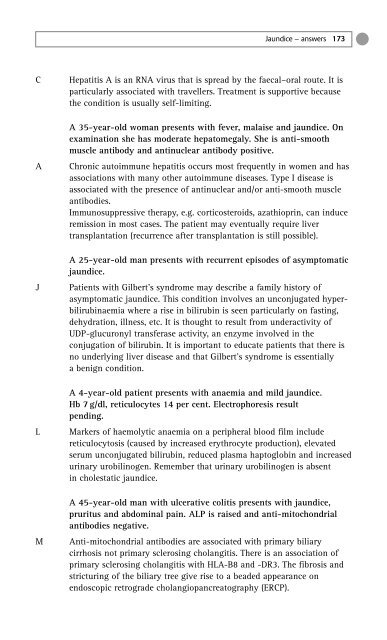EMQs in Clinical Medicine.pdf - Peshawar Medical College
EMQs in Clinical Medicine.pdf - Peshawar Medical College
EMQs in Clinical Medicine.pdf - Peshawar Medical College
Create successful ePaper yourself
Turn your PDF publications into a flip-book with our unique Google optimized e-Paper software.
Jaundice – answers 173<br />
C<br />
A<br />
J<br />
L<br />
M<br />
Hepatitis A is an RNA virus that is spread by the faecal–oral route. It is<br />
particularly associated with travellers. Treatment is supportive because<br />
the condition is usually self-limit<strong>in</strong>g.<br />
A 35-year-old woman presents with fever, malaise and jaundice. On<br />
exam<strong>in</strong>ation she has moderate hepatomegaly. She is anti-smooth<br />
muscle antibody and ant<strong>in</strong>uclear antibody positive.<br />
Chronic autoimmune hepatitis occurs most frequently <strong>in</strong> women and has<br />
associations with many other autoimmune diseases. Type I disease is<br />
associated with the presence of ant<strong>in</strong>uclear and/or anti-smooth muscle<br />
antibodies.<br />
Immunosuppressive therapy, e.g. corticosteroids, azathiopr<strong>in</strong>, can <strong>in</strong>duce<br />
remission <strong>in</strong> most cases. The patient may eventually require liver<br />
transplantation (recurrence after transplantation is still possible).<br />
A 25-year-old man presents with recurrent episodes of asymptomatic<br />
jaundice.<br />
Patients with Gilbert’s syndrome may describe a family history of<br />
asymptomatic jaundice. This condition <strong>in</strong>volves an unconjugated hyperbilirub<strong>in</strong>aemia<br />
where a rise <strong>in</strong> bilirub<strong>in</strong> is seen particularly on fast<strong>in</strong>g,<br />
dehydration, illness, etc. It is thought to result from underactivity of<br />
UDP-glucuronyl transferase activity, an enzyme <strong>in</strong>volved <strong>in</strong> the<br />
conjugation of bilirub<strong>in</strong>. It is important to educate patients that there is<br />
no underly<strong>in</strong>g liver disease and that Gilbert’s syndrome is essentially<br />
a benign condition.<br />
A 4-year-old patient presents with anaemia and mild jaundice.<br />
Hb 7 g/dl, reticulocytes 14 per cent. Electrophoresis result<br />
pend<strong>in</strong>g.<br />
Markers of haemolytic anaemia on a peripheral blood film <strong>in</strong>clude<br />
reticulocytosis (caused by <strong>in</strong>creased erythrocyte production), elevated<br />
serum unconjugated bilirub<strong>in</strong>, reduced plasma haptoglob<strong>in</strong> and <strong>in</strong>creased<br />
ur<strong>in</strong>ary urobil<strong>in</strong>ogen. Remember that ur<strong>in</strong>ary urobil<strong>in</strong>ogen is absent<br />
<strong>in</strong> cholestatic jaundice.<br />
A 45-year-old man with ulcerative colitis presents with jaundice,<br />
pruritus and abdom<strong>in</strong>al pa<strong>in</strong>. ALP is raised and anti-mitochondrial<br />
antibodies negative.<br />
Anti-mitochondrial antibodies are associated with primary biliary<br />
cirrhosis not primary scleros<strong>in</strong>g cholangitis. There is an association of<br />
primary scleros<strong>in</strong>g cholangitis with HLA-B8 and -DR3. The fibrosis and<br />
strictur<strong>in</strong>g of the biliary tree give rise to a beaded appearance on<br />
endoscopic retrograde cholangiopancreatography (ERCP).












